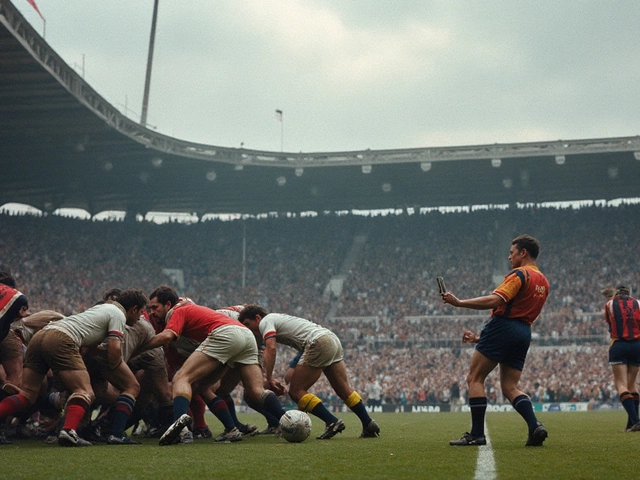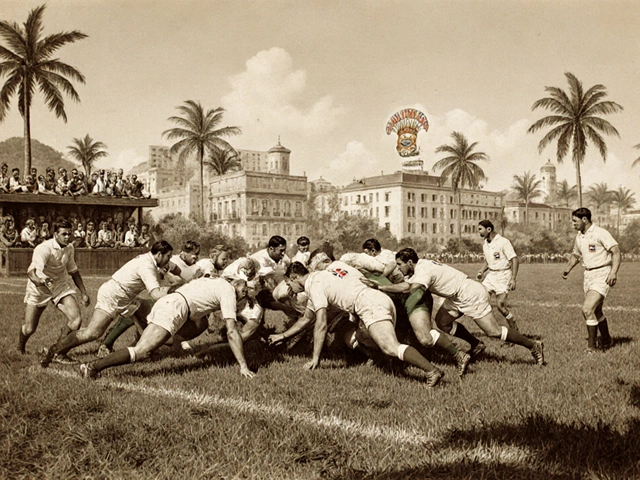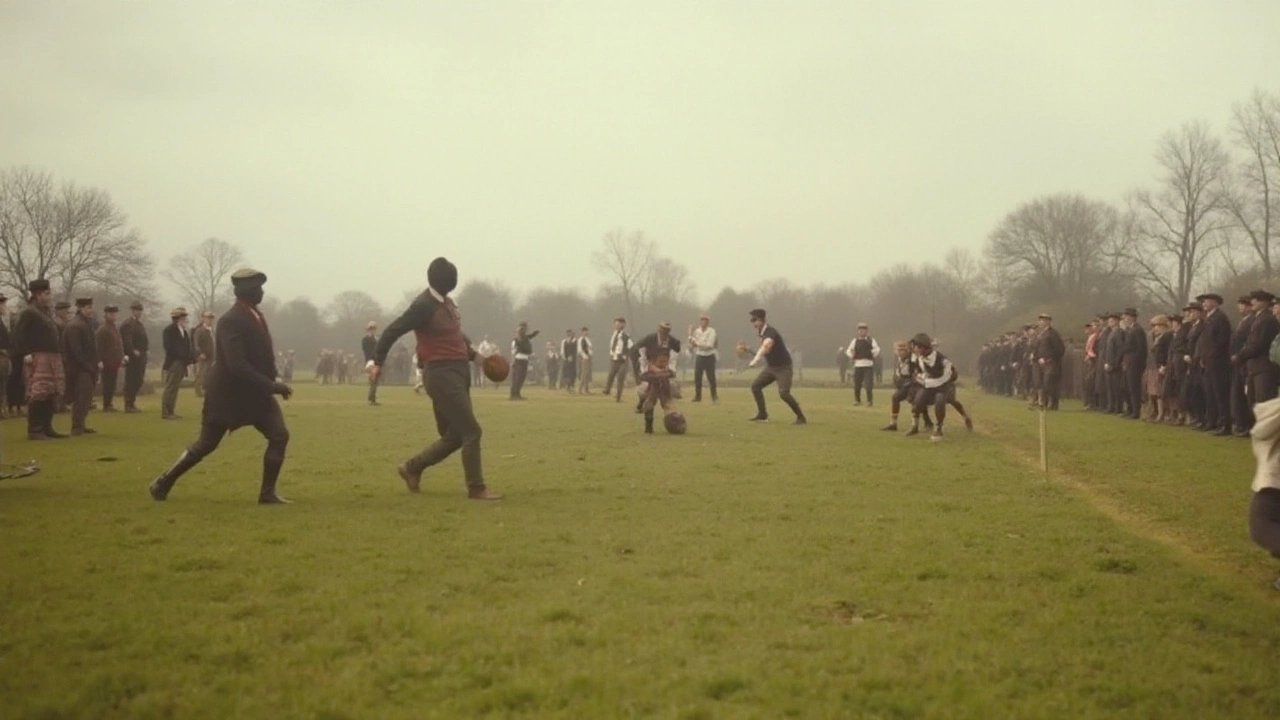
General Sports January 19, 2025
Uncovering the Origins: Rugby vs. Football
As sports fans around the world tune in to thrilling rugby fixtures and nail-biting football matches, few ponder the ancient origins of these beloved games. The rivalry and camaraderie between these two sports has been a source of both confusion and fascination, particularly when it comes to the question: Is rugby older than football?
To understand their timelines, one must journey through history's pages, from the playing fields of medieval England to the codified regulations of the 19th century. This exploration reveals not just the roots of each sport but also how societal shifts and cultural moments shaped them into what we see today.
- Ancient Games Influence
- Emergence of Modern Rugby
- The Birth of Football
- Comparing Rules and Play
- Cultural and Global Impact
Ancient Games Influence
Before getting into the direct lineage of rugby and football, it’s essential to step back in time to the earliest incarnations of organized sport. Ancient civilizations were not strangers to the concept of competitive games, with activities that resembled ball games found in various cultures long before the first rugby ball was ever kicked. The Greeks had 'Episkyros', a game involving teams and a ball, though the rules are lost to history, tantalizing hints suggest a physical, strategic play that bore resemblance to rugby. Beyond Europe, the Chinese dynasty has records of 'Cuju', a military training exercise that involved kicking a ball through an opening, much like football's modern goalposts.
Just across the sea, Mesoamerican civilizations engaged in ball games that carried both recreational and ritualistic significance. The Mayan ball game, for instance, showcased not only athletic prowess but also had deep-seated spiritual undertones, merging the physical with the divine. In these games, elements of skill, team dynamics, and strategic play found their birthplace, echoing through time to influence sports development all over the world. The Roman 'Harpastum' was another forerunner; players would try to keep the ball in their half much like a territorial defense in rugby. These early pastimes laid the groundwork for more structured sports, their essence now embedded in today's sporting events and fixtures.
Gregory McNamee, a scholar in ancient sports, eloquently noted,
"The games of the past are more than dusty relics; they are the building blocks that have shaped our cultural identity and our approach to competition."This ancient legacy has undoubtedly influenced the traits seen in modern rugby and football. The passion for teamwork, the desire for fair play, and the thrill of the crowd—all harken back to days when games were not merely physical contests but vital parts of community life. Notably, many historians suggest that without these ancient influences, the path to today’s structured formats of rugby and football might have taken very different turns, possibly impacting how early society viewed leisure and recreation.
Emergence of Modern Rugby
The history of rugby as we recognize it today began to take shape in the early 19th century. It is often attributed to an infamous moment at the Rugby School in England. Legend has it that in 1823, a student named William Webb Ellis, playing a game of football, defied convention by picking up the ball and running with it. While this tale is somewhat romanticized, it underscores the spirit of rugby's origins—innovation, and deviation from standard rules. By the mid-19th century, rugby's distinct identity was forming as different schools and clubs began adopting its unique style of gameplay.
Organized efforts to establish formal rugby rules culminated in 1845 when the students of Rugby School themselves documented what would become the first codified rules of rugby. These rules permitted the carrying of the ball in the hands and specified methods of tackling, adding structure to the burgeoning sport. By 1871, the formation of the Rugby Football Union further cemented rugby's trajectory, separate from association football. Interestingly, by this time, the game had ventured beyond the British Isles, introducing variations and local adaptations. In Southern Africa, for example, rugby gained a following that would lead to significant historical milestones in sports diplomacy much later on.
Key Developments in Rules
The evolution of rugby is marked by a refinement of its play, regulations, and overall structure. The sport's early years were characterized by vigorous debates over rules, particularly concerning the method of tackling and scoring. In 1871, the first international match was played between England and Scotland. This not only highlighted the game's rising popularity but also signaled a need for standardized laws. A significant development came with the introduction of the 'try'—originally just a means to earn a chance at a goal, the try itself eventually became a scoring method by the 1880s.
The Rugby World Cup encapsulates the spirit of the sport, celebrated in the words of author and former player Clem Thomas, "Rugby is a game for gentlemen of all classes, but never for a bad sportsman."
With its growing global presence, rugby adapted to various cultures while maintaining its identity. During the late 19th century, rugby faced significant regional adaptations. In New Zealand, the integration of Māori players changed the dynamics of the game, showcasing a diverse and inclusive dimension. Meanwhile, the British colonies witnessed the proliferation of the sport, contributing to its worldwide appeal. As of today, the sport boasts teams from over 100 countries, each adding unique elements to its storied history.
| Year | Key Event |
|---|---|
| 1823 | William Webb Ellis incident |
| 1845 | First codified rules at Rugby School |
| 1871 | Formation of Rugby Football Union |
| 1871 | First international match |
| 1880s | Introduction of 'try' as a scoring method |
This era of rugby's development not only established the game's fundamental principles but also highlighted the communal spirit that drives it. Coinciding with an industrial era, which provided the leisure and social framework for such pursuits, rugby's initial growth laid the groundwork for a sport that thrives on camaraderie, respect, and the thrill of competition.
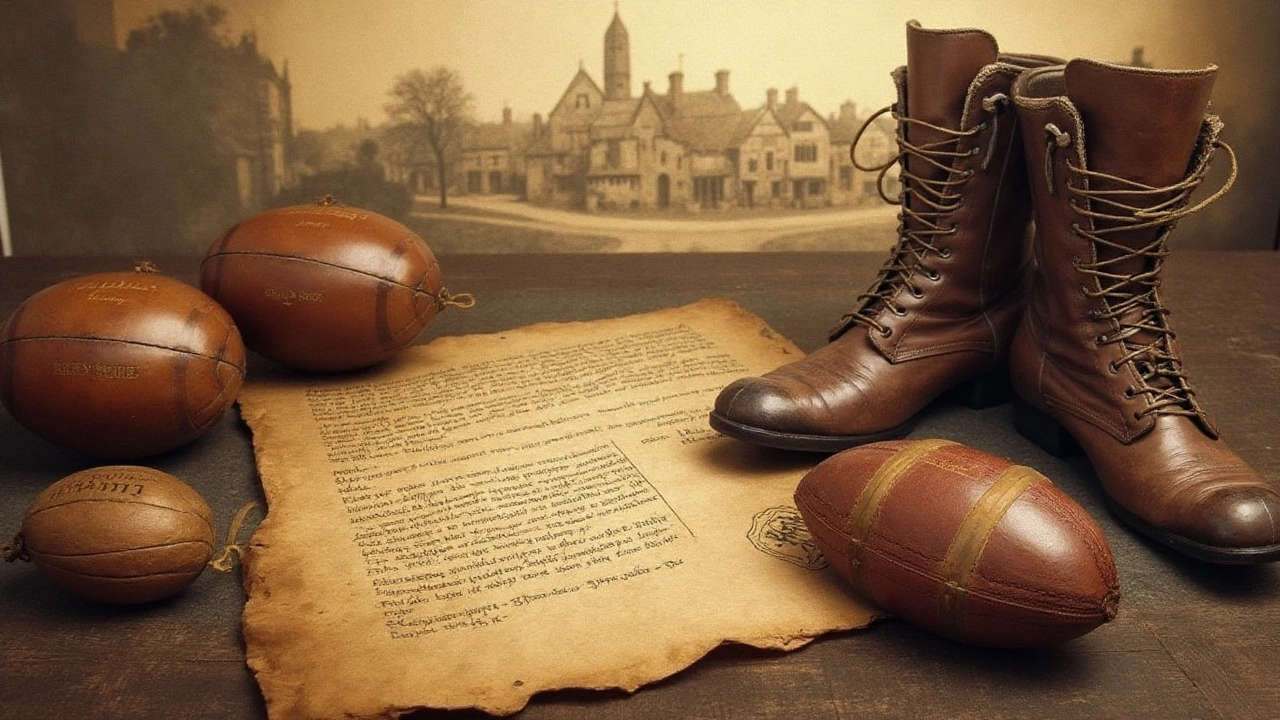
The Birth of Football
As the mists of time begin to clear, the origins of football come into focus. While today the sports world recognizes it as "soccer" in some territories and simply "football" in others, this game's beginnings are deeply woven into the fabric of society across the globe. The modern version of the sport that captivates billions had its genesis in the very heart of Europe. England, in the 19th century, was a bustling hub of innovation and cultural change, and it was here that a more organized form of the game first began to take shape.
The roots of football trace back further, however, with ball games already a staple in cultures around the world. From the boys of ancient Greece who played Episkyros to the more structured Roman Harpastum, kicking a ball to score points held universal appeal. Yet, it was on the muddy fields of England where this disparate collection of games began to evolve into something familiar. The city streets of medieval Europe often hosted riotous games where teams from rival parishes competed with little in the way of rules. These early forms, chaotic as they were, planted the seeds for the later codification of the sport.
In 1863, a pivotal moment arrived. It was a time when the industrial revolution had already spun a web of railways and factories across Britain. The burgeoning urban centers demanded leisure pastimes, and it was in this context that several clubs met in London to establish the Football Association. This historic meeting at the Freemasons' Tavern began to formalize the sport by drawing up a definitive set of rules. The agreed regulations would eventually estrange football from its close cousin, rugby, setting a course towards the association football we recognize today.
The rules of the game, meticulously crafted, sought to blend the physicality of rugby with elements of control and teamwork highlighted in ancient forms. Notably, the banishment of using hands except by the goalkeeper was a significant departure and a clear delineation from rugby. This adaptation allowed the game to flourish in public schools, where it became a staple of physical education. A student of the time might later recall, "
Among the various sports, football taught us resilience and unity as a school, imparting values we carried well beyond the field." Over the years, enhanced rules and refinements paved the way for the formation of professional leagues.
Coinciding with the development was the spread of football across continents. British traders, soldiers, and sailors were often credited with taking the game to far-flung colonies, bringing with them not just a pastime, but a passion. By the turn of the 20th century, the first international matches had been contested, and the game began to cement its status as a global phenomenon. Today, the history of football doesn't just reflect a sport's evolution; it mirrors the changes in society and the unyielding march of time.
Comparing Rules and Play
The rules that distinguish rugby from football are as intricate as the history that binds them. In its essence, modern rugby and football developed from similar ancestral games but evolved with distinct characteristics and regulations that highlight their unique nature. Rugby, officially codified in 1845 at Rugby School in England, initially emphasized a blend of physical endurance and strategic teamwork. It allowed players to carry an oval-shaped ball and make tackles to halt the opposing team's advance, which remains a cornerstone of the sport's character today.
In contrast, football, which formally established its rules with the creation of the Football Association in 1863, focused on a round ball primarily advanced by the players' feet. Though tackling is part of the game, its method is primarily confined to using the body to shield or maneuver rather than tackle to gain possession. Football's simplification of handling and advancing the ball with feet alone led to a game of explosive breaks and elegant strikes at goal, encapsulated in matches that have stirred passions globally.
Rules Breakdown
The delineation of rules between rugby and football touches nearly every aspect of play, from ball handling to score methodologies. Rugby, for example, allows passing the ball sideways or backwards, never forward. Scoring entails a try, achieved by grounding the ball in the opponent's in-goal area, and conversions, where kicking through a goalpost delivers extra points. Football, in contrast, condenses scoring into a single act—getting the ball into the opponent's net. The offside rule, a unique feature of football, adds layers of tactical depth, requiring players to plan offensive plays thoughtfully.
Perhaps what solidifies the perception of rugby as a more physically rigorous spectacle is the nature of scrums and tackles, pivotal for ball retrieval and retention. Football, less physically confrontational, boasts intricate dribbles and strategies that rely on finesse and agility. Each sport's embodiment of differing philosophies not only makes them distinct but also enriches the spectrum of team sports available for fans and players worldwide.
The global reach of these sports is illustrated by the following statistics, which emphasize their cultural and athletic prominence around the world:
| Sport | Estimated Global Fans (millions) | Countries Played |
|---|---|---|
| Rugby | 475 | 115 |
| Football | 4000 | 200+ |
"Football is a game of low scores and psychic blows; rugby is a game of high scores and high pain." - Cliff Morgan
The demographics demonstrate a significant disparity in the reach and popularity of each sport, yet attest to their universal appeal and distinct influences across diverse cultures. With such rich histories and varied forms of play, both rugby and football continue to attract dedicated fans and players whose passions keep these traditions alive, securing their place in the world of sports.
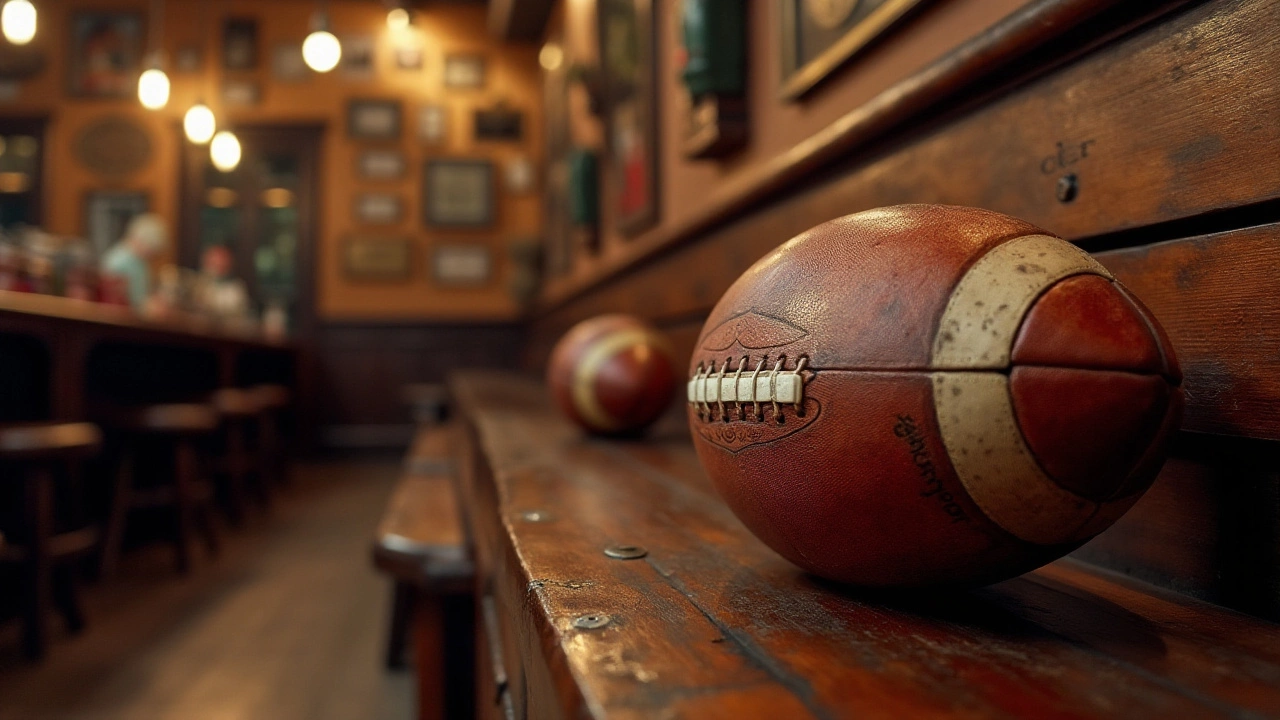
Cultural and Global Impact
Rugby and football have both made profound impacts on societies across the globe, but the ways in which they have done so reflect their unique characteristics and origins. Rugby history, for instance, is rich with tales of camaraderie and grit, often seen as a sport that builds not just physical endurance but strong character and resilience in its players. Originating from the English upper class and spreading through the colonies, rugby became a bridge among various cultures. Its impact can be felt in places as diverse as New Zealand, South Africa, and Argentina, where it transcends the boundaries of mere sport to become an integral part of the national identity.
Football origins, however, trace their roots to many ancient foot games played throughout the world, but it was the British who meticulously shaped it into the global phenomenon it is today. The advent of the Football Association in the 19th century marked the professionalization of the sport, leading to a surge in popularity that swept across continents with incredible speed. Today, football holds the title of the world's most popular sport, an emblem of unity and competition that brings people together every four years at the FIFA World Cup. As legendary footballer Pelé once remarked, "Football is the beautiful game that has the power to unite in a way little else can."
"Football is the ballet of the masses." - Dmitri Shostakovich
The cultural landscapes in which these sports are embedded also influence their global reach and interpretation. While rugby tends to be more popular in the Commonwealth nations, often associated with historic rivalries and local pride, football touches every corner of the planet, transcending linguistic and cultural barriers like no other sport. Stadiums filled with exuberant fans clad in their team's colors are a common sight across the globe, attesting to its unifying force and widespread appeal. The mutual influence of these sports on culture and society cannot be overstated, as they inspire countless stories, films, and even political dialogues, emphasizing their roles as much more than just games.
Shared Influence and Future Trends
The relationship between rugby and football is not only historical but conversational, with each borrowing elements of play and fan engagement from the other. For example, rugby's emphasis on strategic depth and teamwork echoes into football's playing fields, influencing tactics and training regimens. In return, the global popularity of football provides a blueprint for marketing and fan engagement strategies that rugby leagues around the world are keen to emulate. However, both sports face the ongoing challenge of adapting to modern issues such as player safety and inclusivity, ensuring they remain relevant to new generations. As both sports continue to evolve, their potential impact on future cultural and global trends remains substantial, inviting enthusiasts and scholars alike to partake in their ever-unfolding stories.
